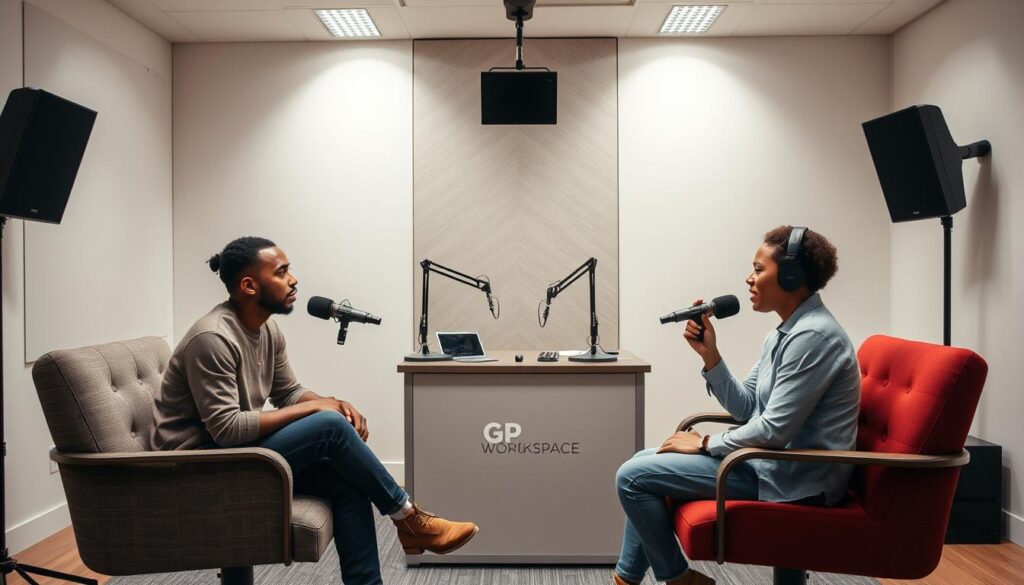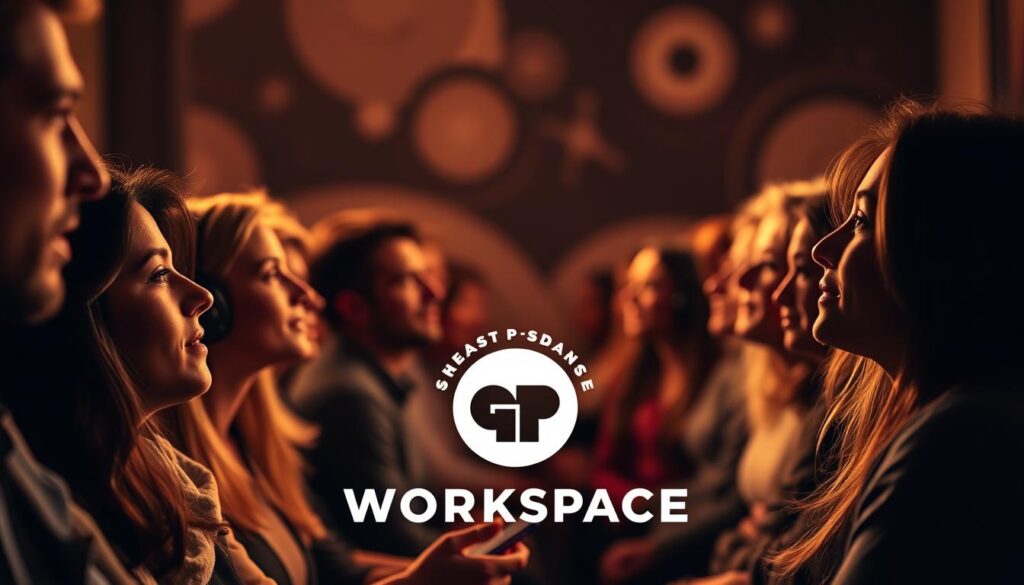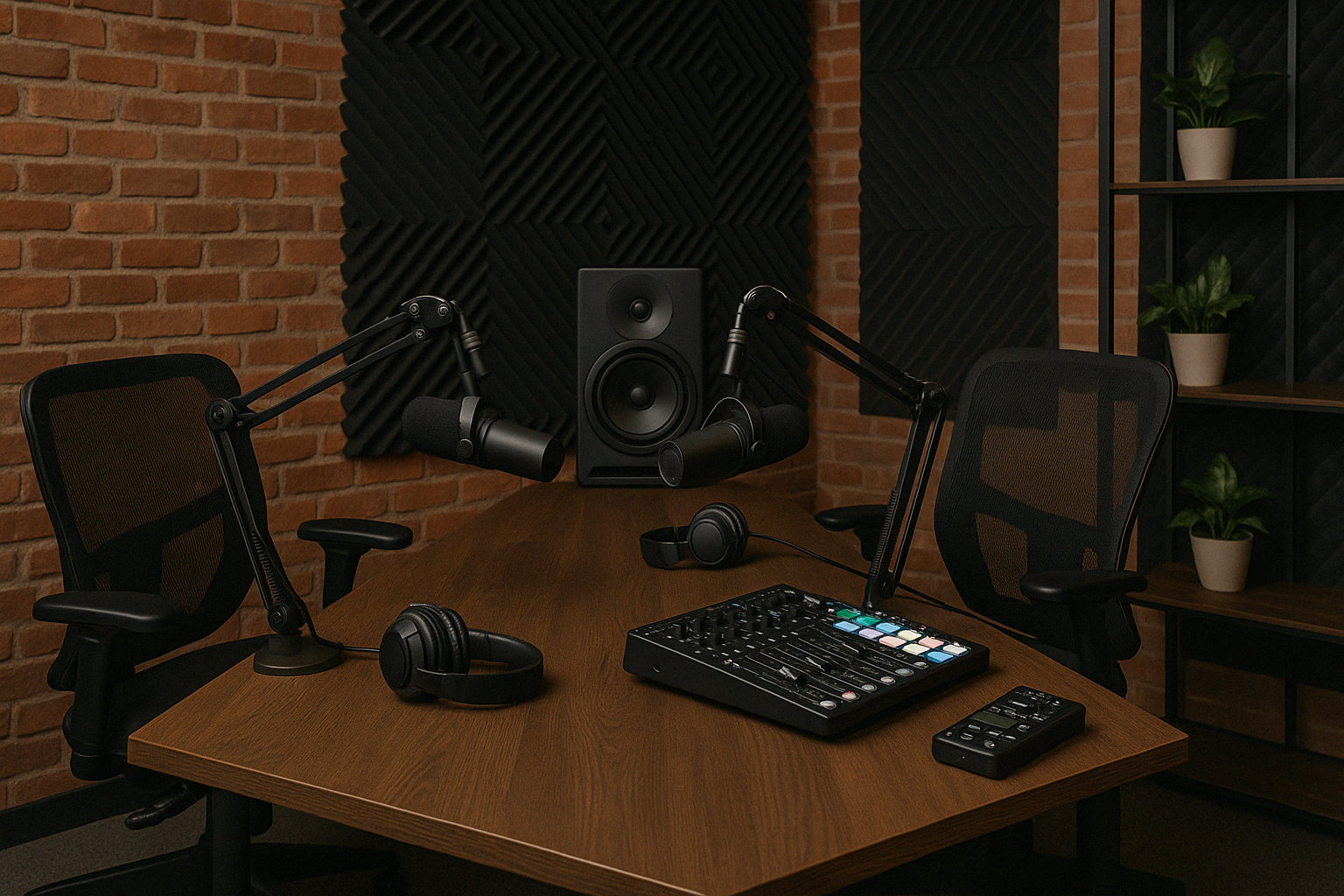Ever wondered how storytelling changes with new tech? In the world of innovative podcasting, this change is obvious. Podcasters are doing more than just talking. They’re creating deep audio stories with a personal touch. This makes you feel like you’re part of the story.
Podcast creators are like chefs in a fancy restaurant. Just like chefs craft dishes, podcasters create episodes with care. They aim to connect deeply with their audience. This could be through an exciting story or a relaxed conversation. The goal is to make each listener come back for more.
Many podcasts feature just one person talking which shows the power of personality in content. Having guests, however, adds variety and depth to the program. This mix of personal and diverse voices makes the podcast more interesting.
Keeping the same format helps keep listeners coming back. It makes working with others easier, boosts professionalism, and helps people talk about the podcast. As podcasters, we strive to meet and surpass what our listeners want.
Let’s explore captivating and inspiring podcasts together. It’s more than hitting play. It’s about immersing in a story through your ears and sometimes, seeing it too. Join us—the next amazing audio story is just a click away.
The Rising Popularity of Solo Podcasts: Commanding Attention with Personality
The charm of the solo podcast format is in how simple and personal it is. It stands out because it has just one host’s unique voice. This way, it uses storytelling skills and podcast charisma to leave a lasting impression on listeners. Let’s look at how doing a podcast alone can make listeners feel closer to the content.
Solo podcast hosts have a big task: they have to keep the show interesting all by themselves. Having podcast charisma is key to keeping listeners hooked. They need to know how to talk in an engaging way, using voice changes and timing. And here, being a good storyteller is not just helpful—it’s necessary. A great story keeps listeners coming back for more.
When a podcast has only one host, it can create a stronger bond with listeners, leading to more audio engagement. This kind of close relationship is harder to find in shows with many hosts. Solo podcasts allow for a special kind of closeness and loyalty, making listeners feel they’re in a personal chat with the host.
Being consistent is critical for success in solo podcasts. Listeners like knowing what to expect and hearing a voice that feels like a friend among many other shows. This makes solo podcast hosts into trusted voices who can really influence their listeners and build a strong personal brand.
To wrap it up, the rise of solo podcasts shows how impactful one person talking can really be. It highlights the power of personal connection and true podcast charisma.
Exploring Video Podcasts: A Visual Approach to Storytelling
Video podcasting is changing the game. It brings a new depth to stories with its visuals. By adding images to sound, podcasters catch more attention. This mix makes shows more interesting and reaches more people.
About 60% of listeners now prefer video podcasts on places like YouTube. They like seeing the story as well as hearing it. For creators, this means it’s time to get good cameras and editing tools. By doing this, they can make shows that look great and pull in more viewers.
Moving to video also helps podcasters make more money through ads and sponsorships. It’s not just a chance to be creative, but also to earn well. Having a strong video plan is critical. It must match the story you’re telling and attract both new and old fans. This way, more people will share your podcast, making it more popular online.
Video podcasting is about more than watching and listening. It’s an experience. Making podcasts becomes an art. Podcasters need to learn how to tell stories in a way that holds people’s attention. We suggest trying this new way. It improves your show’s quality and gets more people to tune in. This can help you stand out in a crowded field.
Embracing the Power of Interview Podcasts: Diverse Perspectives
Interview podcasts have a big impact on both the host and their audience. They shine a light on guest insights and start meaningful conversations. This enriches the listener’s journey with diverse views and deep knowledge from various experts.
This format draws listeners in with the promise of new and exciting content in every episode. Whether it’s about the latest in science or personal success stories, the topics vary widely. But the focus is on engaging talks that are both educational and inspiring, aimed at those eager for depth and diversity.

Adding interviews to your podcasting plan brings more than just varied content. It also helps your podcast reach more people, including the guests’ fans. Each episode doesn’t just share expert knowledge but also uses the guest’s influence. This can quickly spread your podcast’s reach through social media shares and mentions.
Let’s dive into how the interview podcast format can change the listener experience and boost a podcast’s impact:
| Feature | Impact |
|---|---|
| Variety of Guests | Brings diverse perspectives and fresh content, attracting a broad audience spectrum. |
| Depth of Discussion | Enables deep dive into specific subjects, offering valuable insights and knowledge. |
| Network Expansion | Guests’ followers become potential new listeners, expanding reach. |
| Engagement Levels | Compelling discussions encourage listeners to interact, share, and discuss episodes. |
Interview podcasts are more than a way to deliver content. They are a strong tool for making connections, educating, and building a community. They invite listeners to engage, think, and reply. This turns each episode into a chance to learn and start new conversations.
Innovative Podcast Formats
Innovative formats in podcasts are changing how audiences enjoy stories. They mix great storytelling with audio tricks to draw listeners in. This makes the listening experience as fun as it is educational.
Fiction and non-fiction podcasts are both getting more popular. Fiction ones are like TV dramas but you only listen. They need talented voice actors and sound design to build their world. On the other hand, non-fiction podcasts teach you about real stories and history. They tell these tales in a way that makes them stick with you.
| Podcast Format | Features | Audience Engagement |
|---|---|---|
| Fiction | Character-driven plots, sound effects, dramatic arcs | High |
| Non-Fiction | Educational content, real-life stories, narrative depth | High with an educational impact |
These new podcast styles let makers dig into tricky topics and stories. They’re moving past old podcast ways, making listeners think deeply. As makers keep finding fresh ways to use sound, podcasts will keep getting more exciting for everyone.
Hybrid Podcasts: Combining Elements for Unique Experiences
Hybrid podcast formats mix styles to make innovative content creation exciting. They provide varied experiences that grab the listener right away. By combining interviews, stories, and fun or educational parts, they create something special. This mix makes the podcast stand out.
Hybrid podcasts appeal to many listeners. Some like deep talks, others enjoy good stories, or just a laid-back chat. This way, more listeners keep returning for the rich variety they offer. It’s a smart way to attract and keep a wide audience.
These podcasts are a creative space. Creators can play with sound effects, music, and different voices to tell a story better. This keeps the content fresh and engaging. It connects with the audience on a deeper level, making them come back.
Hybrid podcasts are great for all kinds of listeners. Whether you have a short ride or need something for a chill evening, they fit perfectly. Our goal is to challenge old media styles. We want to make unique, meaningful content that touches everyone.
By using hybrid podcast formats, we’re making more than episodes. We aim to create experiences that are fun, informative, and uplifting. This raises the bar in podcasting. It turns simple listening into amazing adventures.
Story-Driven Formats: Elevating Podcast Narratives
Story-driven podcasts are changing the game in audio entertainment. They offer rich, complex stories that do more than just tell tales. They pull listeners into an engaging world that feels real and memorable.
These podcasts transform simple tales into amazing adventures. They mix perfect pacing, powerful sound effects, and captivating tales. This way, they take listeners to new places, making every episode a unique experience. The real magic of these podcasts is how they connect with us, making every story impactful.

Consider the impact in popular genres like true crime or historical fiction. Here, detailed storytelling turns basic facts into unforgettable stories. For those interested in this style, checking out top storytelling podcasts is a great start.
There’s a wide variety of themes and styles out there, showing this medium’s vast potential. Below is a table of podcasts that have nailed story-driven formats.
| Podcast Name | Focus Area | Target Audience |
|---|---|---|
| The Podcast Interview Marketing Show | Marketing strategies through storytelling | Marketing strategists, Entrepreneurs |
| The Storied Way Perspective With Rituparna | Storytelling in various fields | Authors, Educators |
| Strategic Storytelling | Copywriting and marketing strategies | Marketing, Branding Experts |
| The Story Power Marketing Show | Business growth through storytelling | Business strategists, Marketing professionals |
| Stories to Create Podcast | Personal narratives and pivotal moments | Individuals with personal stories |
For those wanting to start a story-driven podcast, the focus should be on narrative engagement. It’s about creating an immersive experience. Each episode should not just entertain but also touch listeners deeply.
Immersive Audio Experiences: Using Soundscapes to Engage Listeners
Podcasting has a unique power with immersive audio. It can take listeners to another world. Soundscapes add depth to each episode, making the podcast more than just sound. They turn listening into a thrilling journey.
We see how important these elements are for today’s podcasting. Immersive audio and soundscapes do more than tell a story. They wrap listeners in sounds, making every moment and emotion feel real. It’s not just listening; it’s experiencing the story.
| Feature | Benefit |
|---|---|
| High-Quality Sound Recordings | Ensures clarity and depth, making the audio landscape as realistic as possible. |
| Skilled Sound Editing | Blends music, effects, and dialogue smoothly to maintain flow and engagement. |
| Convolution Reverb | Adds realistic acoustics that mimic real-life environments, enhancing the believability of settings. |
To include such rich soundscapes takes creativity and a deep knowledge of sound’s effect on feelings and imagination. The result is well worth it. By using sound layers that connect with listeners, podcasts create a strong bond with their audience. This turns listeners from passive to active, making them a part of the podcast’s world.
Seasonal Series: Capitalizing on Timely Content
Seasonal podcast formats have unique benefits by lining up episodes with the right time of the year. This makes sure the content is timely and hits home with listeners. It grabs the audience’s attention and makes the story flow better.
Creating a podcast series around seasons lets makers dig deep into certain themes or events. This gives listeners a detailed adventure that keeps them coming back. Whether it’s about holidays, sports, or culture, each episode is a deep dive into relevant topics.
- Increased listener engagement through relevance
- Opportunity to delve into topics season-by-season
- Planned breaks that build anticipation for upcoming seasons
This approach gives room for careful planning and storytelling. It betters content quality and helps stick to a regular posting schedule. This is key to keeping listeners.
When it comes to podcasting, choosing between an ongoing or seasonal series depends on the content and the team’s goals. A seasonal approach keeps every episode fresh and impactful.
Having timely themes in a structured seasonal framework attracts a broad audience. It builds a devoted community that looks forward to new content every season.
Interactive Podcasts: Engaging the Audience Like Never Before
The interactive podcast format is changing the game in podcast innovation. It turns listeners into active players, boosting audience engagement. They can choose story outcomes, join live polls, or take part in Q&As. This makes each episode exciting and unique.
The move to more engaging content is noticeable. Audience feedback and involvement shape the show. This creates a deeper connection among listeners. Live shows and gamified features make participation rewarding.
Imagine your choices influencing the podcast you listen to. You could pick topics, suggest questions, or determine a story’s direction. This involvement keeps listeners coming back, feeling connected.
We, as podcasters, are thrilled to use these new tools. They help us make content that’s not just fun but also meaningful. Embracing new tech and rethinking strategies are challenges we face. However, the benefits, like better engagement, are worth it.
This new approach shows how versatile podcasting can be. It’s more than just listening; it’s about taking part, feeling, and shaping. This is the essence of podcast innovation. It makes each podcast a teamwork event, improving the listening experience for everyone.
Conclusion
We started a journey through different kinds of podcasts, discovering how they change our bond with listeners. We looked at solo podcasts, video podcasts with their stories, and interviews full of real talk. Each style stands out, showing how flexible and lively podcasts can be.
In today’s battle for audience attention, making a podcast that deeply connects isn’t easy. But, these new podcast types give creators many ways to engage and move listeners. From storytelling podcasts to live discussions, podcasters have a big chance to connect deeply with people.
As guides in this field, we see a bright future for those ready to dive into these chances. Keeping up with what listeners want and using different podcast types is crucial. The podcasts that keep giving value and adapt will succeed. They’ll find their unique place in the exciting world of podcasting.


